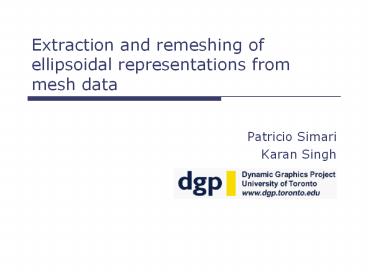Extraction%20and%20remeshing%20of%20ellipsoidal%20representations%20from%20mesh%20data - PowerPoint PPT Presentation
Title:
Extraction%20and%20remeshing%20of%20ellipsoidal%20representations%20from%20mesh%20data
Description:
Extraction and remeshing of ellipsoidal representations from mesh data. Patricio Simari ... unit sphere is sampled, cropped and tessellated. Iterative vertex addition ... – PowerPoint PPT presentation
Number of Views:39
Avg rating:3.0/5.0
Title: Extraction%20and%20remeshing%20of%20ellipsoidal%20representations%20from%20mesh%20data
1
Extraction and remeshing of ellipsoidal
representations from mesh data
- Patricio Simari
- Karan Singh
2
Overview
- Input surface data in mesh form.
- Output ellipsoidal representation approximating
input - Ellipsoidal representation surface defined
piecewise by a set of ellipsoidal surfaces - Ellipsoidal surface ellipsoid plus boundaries
- Used as is or remeshed if desired.
3
Motivation
- Efficient rendering and geometric querying
- Compact representation of large curved areas
- Can also be used to represent volumes
- Direct parameterization of each surface
- Objects perceptually segmented along concavities
4
Related work
- Bischoff et al., Ellipsoid decomposition of
3D-models. - Hoppe et al., Mesh optimization.
- Cohen-Steiner et al., Variational shape
approximation. - Katz et al., Hierarchical mesh decomposition
using fuzzy clustering and cuts.
5
Approximation error
- Total approximation error
- Mesh region (connected set of faces)
- Mesh face
6
Error metrics defined on vertices
Radial Euclidean distance
vi
?P(vi)
P
7
Error metrics defined on vertices
Angular distance
ni
nP(vi)
P
8
Error metrics defined on vertices
Curvature distance
Hi
HP(vi)
P
9
Combining error metrics
- Combined vertex error
- Weights serve dual purpose
- linearly scale metrics to comparable ranges
- Allow user to adjust for relative preference of
one metric over another
10
Negative ellipsoids
- Ellipsoids have positive curvature so they would
not capture surface concavities - Negative ellipsoids remedy this
11
Ellipsoid segmentation algorithm
- Extension of Lloyds algorithm (k-means)
- Fitting step compute Pi that minimizes E(Ri,Pi)
- Classification step assign each face fj to a
region Ri that minimizes E(fj,Pi) - Added constraint regions must remain connected.
- Use flooding scheme (implies losing convergence
guaranty.) - Also include teleportation to avoid local
minima.
12
Remeshing ellipsoidal representations
- Parametric tessellation of surfaces
- unit sphere is sampled, cropped and tessellated
- Iterative vertex addition
- Boundary points are tessellated
- Faces are split at centre with highest error
- Edges are flipped
13
Error metric for ellipsoid volume
- Ellipsoids, being closed surfaces, can also be
used to represent volume. - Same algorithm can be used by adapting error
metric - Regions are approximated by an ellipsoid of
similar volume.
14
Future work
- Segmentation boundaries reduction or do away
with explicit representation - Initialization scheme that decides number of
ellipsoids and gives a good initial placement
15
Using ellipsoidal boundaries
- Each primitive is a polygon which lies on an
ellipsoidal surface - Determine if a point is on the polygon
- Reduce to planar polygon using stereographic
projection.
16
Smoothing segmentation boundaries
17
Impact of different metrics
18
Volume vs. surface fitting































